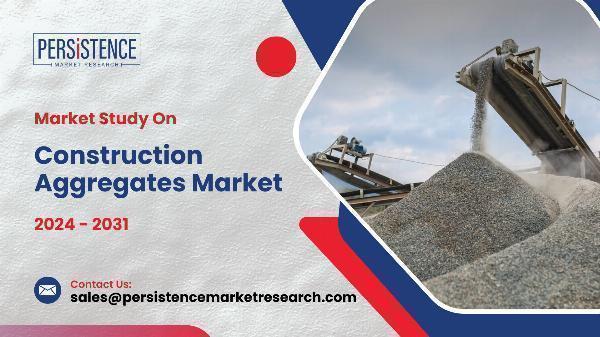Construction Aggregates Market Emerging Technologies to Watch

Strong 8k brings an ultra-HD IPTV experience to your living room and your pocket.
Introduction
The construction aggregates market is a cornerstone of the global construction industry, supplying essential materials like sand, gravel, and crushed stone for various infrastructure and building projects. As the demand for sustainable and efficient construction practices grows, emerging technologies are reshaping this sector, offering innovative solutions that address environmental concerns, enhance performance, and drive economic efficiency. This article explores some of the most promising technologies transforming the construction aggregates market.
The construction aggregates market encompasses materials such as sand, gravel, crushed stone, and slag used in construction and infrastructure projects. These aggregates are essential for producing concrete, asphalt, and other building materials, contributing to infrastructure development, residential, and commercial construction. The global market for construction aggregates is experiencing robust growth, fueled by rising urbanization, infrastructure projects, and increased construction activities. According to Persistence Market Research, the construction aggregates market is projected to grow at a CAGR of 6.5%, expanding from US$ 392.4 Billion in 2023 to US$ 738.2 Billion by 2033.
Recycling and Reuse Technologies
a. Waste Concrete Recycling: One of the most significant advancements in the construction aggregates market is the increased focus on recycling waste concrete. Traditional methods of disposal involve landfilling, which poses environmental challenges. However, new technologies are now enabling the effective crushing and reprocessing of old concrete into high-quality recycled aggregates. Techniques such as advanced crushing equipment and separation processes help produce recycled aggregate with performance characteristics comparable to virgin materials.
b. Asphalt Recycling: Recycling asphalt has also seen considerable technological progress. The development of high-efficiency plants for Reclaimed Asphalt Pavement (RAP) allows for the extraction and reuse of asphalt binder and aggregates from old road surfaces. Technologies like hot-in-place recycling and cold recycling are reducing the need for new asphalt and minimizing waste, making road construction more sustainable.
Smart Aggregates
a. Sensor-Embedded Aggregates: The integration of sensors into construction aggregates represents a groundbreaking innovation. Smart aggregates equipped with embedded sensors can monitor structural health in real time. These sensors measure parameters such as strain, temperature, and moisture, providing valuable data for assessing the condition and durability of structures. This technology not only enhances safety but also allows for predictive maintenance and extends the lifespan of infrastructure.
b. Self-Healing Concrete: Related to smart aggregates is the development of self-healing concrete, which incorporates special additives or bacteria that react with moisture to repair cracks autonomously. This technology reduces the need for frequent repairs and maintenance, thereby lowering long-term costs and improving the resilience of concrete structures.
Sustainable Production Techniques
a. Low Carbon Footprint Production: The construction aggregates industry is increasingly adopting low-carbon production methods to reduce its environmental impact. Technologies such as carbon capture and storage (CCS) are being employed to capture CO2 emissions from aggregate production processes. Additionally, the use of alternative fuels and energy-efficient equipment helps minimize the carbon footprint of aggregate production.
b. Bio-Based Aggregates: Innovations in bio-based aggregates involve the use of renewable materials such as agricultural by-products or industrial waste to replace traditional aggregates. For example, materials like rice husk ash, crushed walnut shells, and even algae-based aggregates are being explored as sustainable alternatives. These bio-based aggregates not only reduce reliance on non-renewable resources but also offer unique properties that can enhance the performance of construction materials.
Request a sample copy: https://www.persistencemarketresearch.com/samples/5201
Advanced Material Processing
a. Nanotechnology: Nanotechnology is revolutionizing the construction aggregates market by improving the properties of aggregates at a microscopic level. Nano-engineered additives can enhance the strength, durability, and workability of concrete and other construction materials. For instance, nano-silica and nano-clay are being used to create high-performance concrete with improved resistance to environmental degradation and mechanical stress.
b. High-Pressure Grinding Rolls (HPGR): High-Pressure Grinding Rolls (HPGR) represent a cutting-edge technology in aggregate processing. HPGRs apply high pressure to crush and grind ores and aggregates, resulting in a more efficient and energy-saving process compared to traditional methods. This technology enhances the quality of the aggregates produced and reduces operational costs.
Automated and Digital Solutions
a. Automated Quarrying and Processing: Automation is transforming quarry operations with technologies such as autonomous drilling and blasting systems, robotic sorting, and automated loading and transportation. These advancements increase efficiency, reduce labor costs, and improve safety in quarry environments. Automated systems also provide real-time data and analytics, enabling better decision-making and operational optimization.
b. Digital Twin Technology: Digital Twin technology involves creating a virtual replica of physical assets, such as aggregate processing plants or construction sites. By simulating and analyzing the performance of these assets in a digital environment, stakeholders can optimize processes, predict maintenance needs, and enhance overall efficiency. This technology is increasingly being adopted in aggregate production to streamline operations and improve resource management.
Geopolymer Aggregates
a. Geopolymer Concrete: Geopolymer concrete is an emerging alternative to traditional Portland cement-based concrete. It uses industrial by-products such as fly ash or slag as binders, which significantly reduces carbon emissions associated with cement production. Geopolymer concrete aggregates are gaining attention for their superior mechanical properties, fire resistance, and lower environmental impact.
b. Synthetic Aggregates: The development of synthetic aggregates involves creating aggregates from industrial by-products or other non-natural sources. Synthetic aggregates can be engineered to meet specific performance criteria and offer advantages such as reduced weight, enhanced durability, and lower environmental impact. These aggregates are particularly useful in specialized applications where traditional materials may not be suitable.
Conclusion
The construction aggregates market is undergoing a significant transformation driven by technological advancements and a growing emphasis on sustainability. Emerging technologies such as recycling and reuse innovations, smart aggregates, sustainable production techniques, advanced material processing, automated solutions, and geopolymer aggregates are reshaping the industry. These technologies not only address environmental concerns but also enhance the performance, efficiency, and safety of construction materials. As the demand for sustainable and high-performance construction solutions continues to rise, staying abreast of these emerging technologies will be crucial for stakeholders in the construction aggregates market.
Follow Us: LinkedIn | Medium | Twitter
Note: IndiBlogHub features both user-submitted and editorial content. We do not verify third-party contributions. Read our Disclaimer and Privacy Policyfor details.


